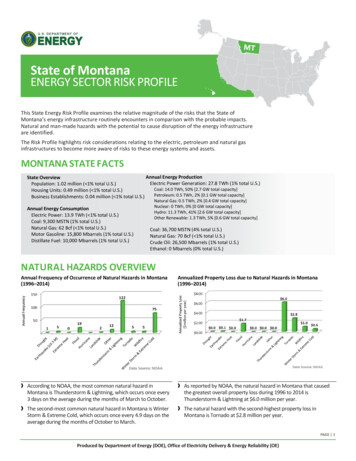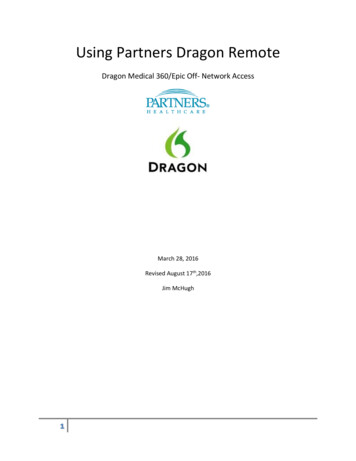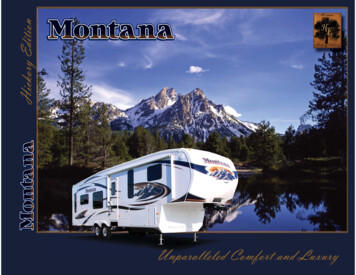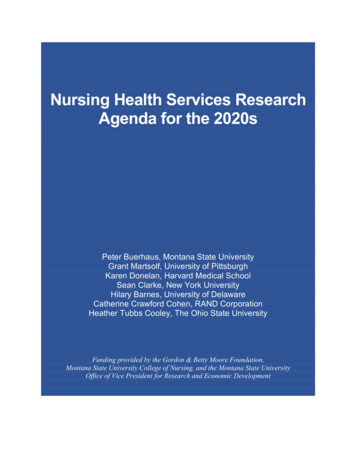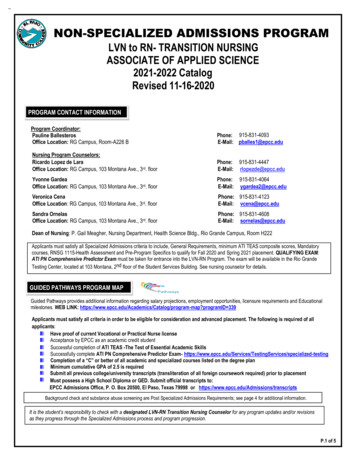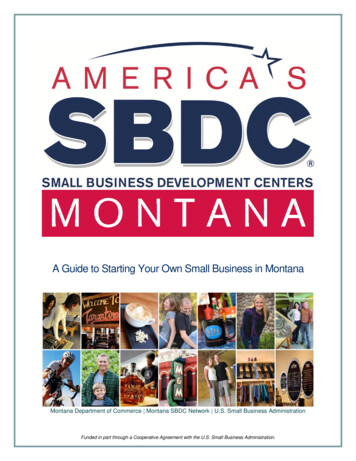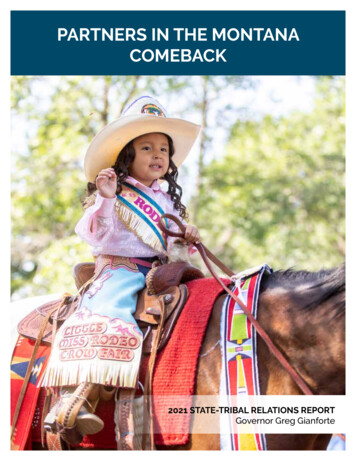
Transcription
PARTNERS IN THE MONTANACOMEBACK2021 STATE-TRIBAL RELATIONS REPORTGovernor Greg Gianforte
Cover photo: Little Miss Rodeo at Crow Fair. Photo by the Department of CommerceREPORT CONCEPTS, WRITING, AND EDITING TEAM: Misty Kuhl, ToryScribner, Guylaine Gelinas, Travis Hall, Brooke Stroyke, Jack O’Brienand policy advisors to the Governor’s OfficeREPORT DESIGN AND LAYOUT: Brandee Hay, State Print & MailState agencies, tribal partners, and private entities submitted primarymaterials that comprise the 2021 State-Tribal Relations Report. TheGovernor’s Office is grateful to all who have contributed resources tothe production of this report, including materials, funding, and time.For further information, contact the Governor’sOffice of Indian Affairs.State CapitolP.O. Box 200801Helena, MT 59620-0801(406) 444-3111 (phone)(406) 444-5529 (fax)tribalnations.mt.gov2
Office Of the GOvernOrStateOfMOntanaKriSten JuraSLt. GOvernOrGreG GianfOrteGOvernOrSeptember 15, 2021I’m pleased to present to you the 2021 State-Tribal Relations Report, “Partners inthe Montana Comeback.”A symbol of the strong collaboration between the State of Montana and ourTribal Partners, this report highlights our joint efforts to foster growth, preservetraditions, and create greater opportunity in Indian Country.The past year has presented the eight Tribal Nations in Montana and the entirestate with real, serious challenges. Through it all, we’ve seen the resiliency oftribal communities in Montana.Working together, we have advanced our shared priorities – boosting economicdevelopment, improving infrastructure, conserving our environment, andpreserving and showcasing Native culture. Critically, we have also madeprogress to combat the crisis of Missing and Murdered Indigenous Persons.As we lead the Montana comeback together, we will continue meeting withTribal governments and peoples and collaborating to promote the sustained,long-term prosperity of Indian Country.It’s an honor to serve as your governor. My door is always open.Sincerely,Greg GianforteGovernorS tate CapitOL P.O. BOx 200801 HeLena, MOntana 59620-0801teLephOne: 406-444-3111 fax: 406-444-5529 WeBSite: WWW.Mt.GOv3
EXECUTIVE SUMMARYGovernor Greg Gianforte proudly presents the first State-Tribal Relations Report of his administration. Thereport, which covers accomplishments in Montana for the state fiscal year 2021, provides informationabout the successful efforts borne from strong collaboration between the State of Montana and TribalPartners.This annual report has been presented to Montana’s tribal governments since 2003, as mandated byMontana Code Annotated § 2-15-143.The report contains five sections and four appendices:Section I, Legislative Resources and Accomplishments – provides information on legislative resources and describes the successes of the 2021 Legislative Session for Native communities.Section II, Economic Development and Infrastructure – showcases programs and active measuresto boost economic development and improve infrastructure in Indian Country, including supportingNative small business owners, entrepreneurs, and agricultural producers.Section III, Education and Culture – describes successful efforts to improve educational opportunities available to Native students, promote tribal contributions to Montana history, and preserve andshowcase Native cultures.Section IV, Natural Resources and Wildlife – details collaborative initiatives between the State ofMontana and the eight Tribal Nations in Montana to conserve our environment, promote better stewardship of our forests, and responsibly develop our natural resources.Section V, Safe and Healthy Communities – outlines efforts to promote safe and healthy communities, including responding to the COVID-19 pandemic, increasing health care resources, combatingthe crisis of Missing and Murdered Indigenous Persons, and protecting against fraud.Appendix A – provides contact information for the eight Tribal Nations in Montana.Appendix B – details gubernatorial appointments of American Indians serving Montana on stateboards, councils, and committees.Appendix C – provides a list of key Governor’s Office staff and Cabinet members.Appendix D – showcases more than 500 agreements, negotiations, and collaborative efforts that occurred during state fiscal year 2021 between the state and the eight Tribal governments in Montana.4
TABLE OF CONTENTSGOVERNOR'S MESSAGE . 3EXECUTIVE SUMMARY.4TABLE OF CONTENTS.5TRIBAL NATIONS OF MONTANA. 6RESOURCES AND LEGISLATIVE ACCOMPLISHMENTS.7ECONOMIC DEVELOPMENT AND INFRASTRUCTURE.13EDUCATION AND CULTURE.26NATURAL RESOURCES AND WILDLIFE.38SAFE AND HEALTHY COMMUNITIES.48APPENDIX A: TRIBAL NATIONS' MAIN CONTACTS .59APPENDIX B: AMERICAN INDIANS SERVING MONTANA . 60APPENDIX C: GOVERNOR’S OFFICE AND CABINET AGENCIES’ MAIN CONTACTS .63APPENDIX D: STATE-TRIBAL AGREEMENTS.655
TRIBAL NATIONS OF MONTANABLACKFEET RESERVATIONHome of the Blackfeet Nation headquartered inBrowning, MontanaFORT PECK RESERVATIONHome of the Assiniboine & Sioux Tribes headquartered in Poplar, MontanaCROW RESERVATIONHome of the Crow Nation headquartered in CrowAgency, MontanaLITTLE SHELL TRIBE OF CHIPPEWA INDIANSHeadquartered in Great Falls, MontanaFLATHEAD RESERVATIONHome of the Confederated Salish, Pend d’Oreille &Kootenai Tribes headquartered in Pablo, MontanaFORT BELKNAP RESERVATIONHome of the Gros Ventre & Assiniboine Tribesheadquartered in Fort Belknap Agency, MontanaNORTHERN CHEYENNE RESERVATIONHome of the Northern Cheyenne Tribe headquartered in Lame Deer, MontanaROCKY BOY’S RESERVATIONHome of the Chippewa & Cree Tribes headquartered in Rocky Boy Agency, Montana6
RESOURCES AND LEGISLATIVEACCOMPLISHMENTSMontana’s Indian Country has continually proven itsresilience and strength. Governor Gianforte has longbeen a champion for our Tribal Nations. The governorhonors sovereignty while also ensuring Tribal Nationshave resources for critical priorities, including economicdevelopment and growth, education, and healthycommunities.During the 67th Regular Session of the Montana Legislature,which convened in January 2021, the governor partneredwith members of the Legislature, including members of theMontana American Indian Caucus, to preserve the cultureof our Native communities, protect the vulnerable, increaseeducational opportunities, and improve infrastructure.One of the key measures to expand opportunities wasHouse Bill 632, which appropriates 2.1 billion in federalfunds from the American Rescue Plan Act (ARPA) towardeconomic recovery, workforce development, businessinnovation, broadband infrastructure, water and sewerimprovements, health and human services, education,and more. Since tribal governments are included as “localgovernments” in the legislation, tribes are eligible forfunding where local governments are eligible.Governor Gianforte gifted the signature pen to Cheryl Horn after signing intolaw bills addressing MMIP in our state. Members of the Montana AmericanIndian Caucus, Director of Indian Affairs Misty Kuhl, and supporters of thebills were in attendance. Photo by Garrett Turner7
OFFICE OF INDIAN AFFAIRSSTATE-TRIBAL RELATIONS COMMITTEEThe Office of Indian Affairs has a clear mission: tocollaborate with tribes and Native communities inMontana to promote economic, spiritual, social,and physical health and wellness.Between legislative sessions, the State-Tribal Relations Committee (STRC) acts as the Legislature’sliaison with tribal governments in Montana. Tenmembers, four from the Montana State Senateand six from the Montana House of Representatives, comprise the bipartisan committee, whichmeets with tribal leaders to hear their concernsand receive input on various topics of interest tothe tribes and the state. The STRC typically visitstwo to four reservations per interim. This interim,the committee’s goal is to visit each reservation.The committee encourages intergovernmentalcooperation, conducts wide-ranging interim studies, and reports its activities, findings, and recommendations, including legislation, to the nextLegislature.Misty Kuhl, an A’aniiih member of Fort BelknapIndian Community, leads the Governor’s Office ofIndian Affairs. Born and raised in Montana, DirectorKuhl is a cum laude graduate of Montana StateUniversity-Billings.During the 2021 Legislative Session, the Office ofIndian Affairs coordinated efforts with the MontanaAmerican Indian Caucus, the State-Tribal RelationsCommittee, legislators, and community stakeholders to advocate for issues important to IndianCountry. These efforts led to successful retentionof Montana’s Indigenous Language PreservationProgram, the preservation of two tribal leadershippositions at DPHHS, and the passage of legislationto promote education and safety for Indian Country.Dedicated to community outreach, Director Kuhlhas traveled thousands of miles to partner withtribes on various projects and strengthen relationships. She looks forward to continuing the governor’s commitment to being actively engaged inour tribal communities and a strong advocate forIndian Country.“I am grateful for the opportunity to serve Montanaand our Native nations. I love our state and ourvibrant, resilient, and strong tribal communities.I’m committed todoing the best work Ican in this importantrole. Our governorcares deeply aboutNative issues, andI appreciate theprivilege of executinghis vision.”– Misty Kuhl, Directorof the Governor’sOffice of Indian Affairs.Photo provided byMisty KuhlThe STRC recently elected new leadership: Rep.Tyson Running Wolf of Browning will serve asChairman, and Sen. Jason Small of Busby willserve as Vice Chairman. You can access the Committee’s full membership roster, meeting dates,and meeting materials at https://leg.mt.gov/committees/interim/strc/.“We feel it’s important to meet with tribes, listento their concerns, try to address them, andprovide them with a voice in the Legislature.”– Sen. Jason Small, Former STRC ChairmanMONTANA AMERICAN INDIAN CAUCUSThe Montana American Indian Caucus (MAIC)serves an essential role in state government, bothrepresenting Native American constituents andproviding guidance to the Legislature and the Administration. A bipartisan group of Native AmericanRepresentatives and Senators comprise the caucus. Throughout the 2020-2021 fiscal year, MAICfocused on addressing the Missing and MurderedIndigenous Persons crisis, protecting Indigenousrights in Montana, expanding economic and socialopportunities for Indian Country, and broadeningeducational possibilities for Native Americanstudents.8
LEGISLATIVE ACCOMPLISHMENTSMISSING AND MURDERED INDIGENOUSPERSONSIn Montana, Native Americans make up about 7percent of the population, but they account forabout 26 percent of missing persons. Between2017 and 2019, nearly 80 percent of those reported missing were teenagers younger than 18 yearsof age. Native American women face a murderrate 10 times higher than the national average, and84 percent experience some form of violence intheir lifetime.In a continued bipartisan effort to address theepidemic of people that go missing or are foundmurdered in Montana’s Indian Country, Representative Sharon Stewart-Peregoy of Crow Agencyand Senator Jason Small of Busby sponsored legislation critical to aid in this crisis.“The intent of this suite of bills is to ensurethat gaps in the justice system and lawenforcement system are filled so that ourbrothers, sisters, aunts, and uncles arefound and brought home”– Representative Sharon Stewart-PeregoyRepresentative Stewart-Peregoy’s House Bill 35establishes the Missing and Murdered IndigenousPersons Review Commission at the Montana Department of Justice. Her House Bill 98 extends theMissing and Murdered Indigenous Persons TaskForce and the Looping in Native Communities(LINC) grant program. Senator Small’s Senate Bill4 extends the Missing and Murdered IndigenousPersons Task Force.“The Missing and Murdered IndigenousPersons crisis has tragically impactedfar too many families in Montana, and letme be clear: it must end. The victims andtheir families deserve justice and thesebills give us the tools we need to trackdata, raise awareness, and strengtheninteragency collaboration to protectMontana’s Indigenous persons.”– Governor Greg GianforteECONOMIC DEVELOPMENT ANDINFRASTRUCTURERepresentative Llew Jones of Conrad sponsoredHouse Bill 2, the General Appropriations Act. Inthis legislation, 1.75 million was allocated in grantfunds over the next biennium to the Indian Country Economic Development (ICED) program. Thisprogram provides small equity grants, businessadvisor host organization funds, and tribal government business planning resources. Funding isdistributed to the eight Tribal Nations and to tribalmember businesses.Sponsored by Representative Frank Garner ofKalispell, House Bill 632 provides for the implementation and allocation of federal stimulus andCOVID recovery funds from the federal AmericanRescue Plan Act. Under H.B. 632, tribal governments are considered “local governments” and areeligible to submit competitive grant applicationsfor the 250 million provided in ARPA for waterand sewer infrastructure projects. Additionally,several ARPA funding streams through the U.S.Department of Health and Human Services arespecifically open to the tribal governments.9
House Bill 252, sponsored by RepresentativeJones, addresses the growing skilled labor shortage in Montana by creating the Montana TradesEducation Credit (M-TEC). The bill provides 1million per year in 50% credits to businesses fortheir employees to learn a skilled trade. The funding level could support as many as 1,000 scholarships annually. The credits that may be claimedfor qualifying training expenses by a business arecapped annually at 2,000 per employee and 25,000 per employer/taxpayer. This opportunityis available to off-reservation businesses that employ Native employees.Senator Jason Ellsworth of Hamilton sponsoredSenate Bill 297, the ConnectMT Act, to establishbroadband infrastructure deployment program. 275 million in ARPA federal funds will be available to expand broadband infrastructure andconnectivity access throughout Montana. The billalso provides for an additional 175 million in localmatching funds. The ConnectMT Act also definesfrontier and underserved areas. According to theFederal Communications Commission, about 1 in3 Montanans do not have access to broadband,which is three times the national average. Connectivity issues affect many members of Montana’sIndian Country, and the ConnectMT Act will helpaddress the lack of broadband infrastructure fortribes“Too many of our communities,particularly in rural Montana and on ourreservations, don’t have access to reliablebroadband. Greater access to broadbandwill increase opportunities for Montanans,whether in ag or high-tech or otherMontana industries, but we need to getmore cable in the ground. Back in May,we made a historic investment to closethe digital divide and expand Montanans’access to broadband.”– Governor Greg GianforteEDUCATIONThe governor’s biennial budget allocated 1.5million to continue the Montana Indian LanguagePreservation (MILP) program. Sponsored in 2013by then-Senator and current Representative Jonathan Windy Boy of Box Elder, Senate Bill 342’spurpose is to “preserve and protect Montana triballanguages for this and future generations.” As thepopulation of Native language speakers in tribalcommunities dwindle, the continuation of fundingfor this program is critical to preserving Indigenouslanguages in Indian Country.House Bill 671, sponsored by Representative David Bedey of Hamilton, moves the MILP programfrom the Montana Department of Commerce tothe Office of Public Instruction. House Bill 671 alsoeliminates the termination dates of the MILP program. This legislation will help provide long-termcontinuity for the MILP program.To help address the educational disparity in tribalcommunities, House Bill 2 provides 1.675 millionfrom the general fund to the Office of the Commissioner of Higher Education to reimburse colleges for costs associated with non-tribal memberstudents. An additional 350,000 in general fundswere allocated to HiSET (High School EquivalencyTest) programs at tribal colleges to provide specific classes and training to individuals and studentspreparing to complete their high school equivalency diploma.House Bill 2 also appropriated 80,000 from thegeneral fund for Native American and Culturalcourse development through the Montana DigitalAcademy. The intention is for these courses to bedeveloped and implemented by cultural preservation specialists with the potential for partnershipswith tribal colleges.Recognizing Native Americans underrepresentation in the technology industry, House Bill 644,sponsored by Representative Jonathan WindyBoy, appropriates 64,000 to provide scholarshipsto educators at reservation high schools to takean accelerated computer programming course10
like the Joy and Beauty of Computing at MontanaState University in Bozeman. The educators canthen help support the development of computerprogramming courses at their reservation highschools, increase interest among Indian studentsto pursue computer programming and othertechnology-related careers, and enhance technology-related economic development in IndianCountry. H.B. 644 offers teachers up to 2,000in scholarships for professional development intechnology-related fields. These scholarships areavailable to teachers employed at reservationhigh schools or high schools that serve Little Shellstudents.Since Montana’s Indian reservations face a shortage of teachers, Representative Tyson RunningWolf’s House Bill 403 creates a “Grow Your Own”teacher grant program that appropriates 1 million to the Office of the Commissioner of HigherEducation to develop teacher pipelines aimed atserving rural and reservation school districts. AsMontana’s rural schools struggle to recruit andretain teachers, including in Indian Country, thislegislation will help provide qualified, Indigenousteachers for Native communities.With Native American high school students lesslikely to graduate from high school compared totheir non-Native peers, Senate Bill 18, sponsoredby Senator Dan Salomon of Ronan, allows students who experienced education disruption toearn their high school diploma if they meet theminimum credit requirement established by theadministrative rules of the Board of Public Education. Education disruption includes homelessness,involvement in the child welfare or juvenile justicesystem, a medical or mental health crisis, or another event considered a qualifying educationaldisruption by the trustees of the district. S.B. 18 willreduce the pressure on many Indian students tomeet a district’s graduation requirements shouldthe district’s requirements exceed those of theBoard of Public Education.SAFE & HEALTHY COMMUNITIESAs Montana and our Tribal Nations face a drugcrisis that devastate our families and communities,Representative Mike Hopkins of Missoula sponsored House Bill 701. The new law authorizes Governor Gianforte’s Healing and Ending Addictionthrough Recovery and Treatment (HEART) Fund,keeping the governor’s commitment to bringingmore resources to combat the drug epidemic.With 500,000 in grants for tribes, the HEARTFund will provide new supports to address substance abuse in Indian Country. Community-basednon-governmental organizations and nonprofitgroups that serve Indian Country will also be eligible to receive funds.House Bill 309, sponsored by Representative JoeRead of Ronan, allows for tribal and local government cooperation regarding abandoned vehicles.H.B. 309 gives a tribal law enforcement agency theright to take any vehicle considered to be abandoned into custody if the tribal government hasentered into a cooperative agreement with theMontana Highway Patrol, the sheriff of a county, orthe city police. This bill gives the tribal law enforcement agency the same authority as local lawenforcement once those conditions are met.In an effort to increase safety on highways onMontana’s reservations, Senator Jason Smallsponsored Senate Bill 3, which allows for additional motor carrier enforcement on highwayswithin boundaries of a reservation whose tribalgovernment has entered into an agreement withthe Montana Department of Transportation. Thisbill calls for a state-tribal cooperative approach toenforcing motor carrier safety standards in IndianCountry.Senator Janet Ellis of Helena sponsored SenateBill 14 to make qualified tribal government entitieseligible to receive grants for costs of operatingor implementing a 9-1-1 system. Eligible costsinclude emergency telecommunication systemsplans; project feasibility studies or project plans;the implementation, operation, and maintenanceof 9-1-1 systems, equipment, devices, and data;11
and purchasing service that supports 9-1-1 systems. This bill will potentially help emergencyresponse times in tribal communities.Senate Joint Resolution 26, introduced by SenatorDiane Sands of Missoula, calls for a joint resolutionrequesting an interim study of the adequacy of theMontana Women’s Prison facility and its programs.This effort intends to address the adequacy ofphysical facilities, the overrepresentation of NativeAmerican inmates, programming for educationalopportunities equal to those at the men’s facilities,and the lack of geriatric facilities to accommodatethe growing population of aging inmates. Eventhough Native Americans represent approximately7 percent Montana’s population, Native Americansrepresent approximately 18 percent of the totalpopulation served by the Montana Department ofCorrections.MAKING & RECOGNIZING HISTORYHouse Bill 34, sponsored by Representative FrankSmith of Poplar, updates Montana statutes toreflect the federal recognition of the Little ShellTribe of Chippewa Indians, which was achieved in2019 after the tribe fought for the recognition forover 70 years.Senate Bill 96 establishes the Helen Clarke Memorial Highway on U.S. Highway 2 from the limitsof East Glacier to the limits of Browning. Sponsored by Senator Susan Webber of Browning, thisbill honors Helen Clarke, born in 1846 to a Scottish-American father and a Blackfeet mother. Helen Clarke was elected in 1882 as Lewis and ClarkCounty Superintendent of Schools, one of the firsttwo women and the only person of Indian descentto hold elective office in Montana Territory. Sheheld the position for three terms and went on toa career in various positions before her death in1923. The State of Montana honors Clarke for herwork in improving the quality of life and equality ofopportunity in her time.Sacagawea, who spoke both Shoshone and Hidatsa, traveled for over 16 months with the Lewisand Clark Expedition, delivering a child en routeSigning ceremony for SB 96 held at the State Capitol: (leftto right/front row) Representative Rynalea Whiteman Pena,Governor Greg Gianforte, and Senator Susan Webber; (leftto right/back row) Representative Jonathan Windy Boy andRepresentative Donavon Hawk. Photo by Garrett Turnerand acting as an interpreter in crucial negotiationsbetween members of the expedition and Indiantribes. Senate Joint Resolution 5, introduced bySenator Susan Webber, urges the National ParkService to include Sacagawea on Lewis and ClarkTrail designation signs.LIVESTOCKSponsored by Senator Bruce Gillespie of Ethridge,Senate Bill 26 clarifies that livestock producerson tribal lands are eligible for livestock loss mitigation. Prior to this legislation, producers on triballands were ineligible for livestock loss mitigationpayments if there was no Memorandum of Agreement (MOU) in place between the tribal government and the state. S.B. 26 suspends the requirement of an MOU for loss payments. The additionof tribal lands to the statute effectively means thatanyone who suffers a qualifying loss, regardless ofwhere in the state it happens, is eligible for payment without any unnecessary strings attached.12
ECONOMIC DEVELOPMENT ANDINFRASTRUCTUREThe last year has brought real, serious economic challengesto Indian Country, but through it all, our tribal communitieshave demonstrated their resilience. In the face of pandemicclosures and disruptions, Native business owners investedgrant dollars toward increasing capacity and developingtheir business. Farmers and ranchers in Indian Countrypivoted their operations to meet evolving challenges andmarket demands.As the state emerges from the pandemic and moreAmericans recognize Montana as a top destination fortravel, Governor Gianforte is committed to working withtribal partners to promote to the state’s visitors the uniqueexperiences that only Indian Country can provide.More importantly, the state is making targetedinvestments to boost economic development and improveinfrastructure, helping create greater opportunities for ourtribal communities to prosper.Our state’s eight Tribal Nations are critical components ofMontana’s comeback, and Governor Gianforte looks forwardto collaborating with tribal governments and peoples toincrease prosperity.13
ECONOMIC RECOVERYUnemployment Rate Across Reservations in Montana, neJuThe COVID-19 pandemic threatened the economic and job security of Montanans in every corner of our state. As a result of the severe economic impact of the pandemic, too many Montanans found themselves out of work and without a paycheck, through no fault of their own. Toomany businesses were forced to close their doors. Recognizing both the health and economicimpact of the pandemic, Governor Gianforte entered office in January 2021 committed to combating the virus and its economic fallout.As a result of Governor Gianforte’s efforts to get Montana’s economy going again and get Montana open for business, Montanans throughout our state, including in our Native communities,have been getting back to work. In fact, the June 2020 unemployment rate of 10.5% across reservations had fallen to 6.8% in July 2021.14
OFFICE OF INDIAN COUNTRY ECONOMICDEVELOPMENTThe Montana Department of Commerce(DOC) is committed to enhancing and sustaining a healthy economy so Montanabusinesses, communities, and people canprosper. In addition to economic development programs available statewide, severalprograms are tailored to serve Native entrepreneurs and tribal communities by developing and enhancing business opportunities,increasing access to capital, and creatingjobs. The Office of Indian Country EconomicDevelopment (OICED) oversees these programs and serves as the primary economicdevelopment liaison with Native businessowners and other tribal partners in our state.The OICED’s contributions to economic development ventures during the state fiscalyear 2021 period are featured below.MARIA VALANDRA brings 24 years ofexperience in the banking industry andcommunity development. Currently,she manages the Montana Departmentof Commerce’s Office of Indian CountryEconomic Development (OICED) whereshe oversees a variety of technical assistance and grant programs focused onstrengthening the economy and buildingstrong tribal communities in Montana.Valandra previously worked with Nativecommunity development financial institutions. She also worked at a regionalbank headquartered in Billings, Montana,where she held various positions, including senior vice president, chief synergyofficer, senior vice president of talentmanagement and organization development, and vice president of communitydevelopment. Her past board serviceis extensive, including co-founding the Montana Indian Business Alliance and the MontanaFinancial Education Coalition. Valandra holdsa bachelor’s degree in business managementfrom Montana State University in Bozeman.She is a member of the Nekaneet Band of theCree First Nation of Saskatchewan.“I’ve been in Indian entrepreneurship and tribaleconomic development for over 20 years, and,over time, I’ve seen the growth of Native-ownedbusinesses located in Montana’s Indian Country. There was a time when all the businesseswere owned by non-Natives in tribal communities, but thanks to the work over the yearsof OICED, Native CDFI’s, MIBA and the SBDC’sacross the state, we are seeing more and moreNative-owned businesses starting and expanding. It is very exciting to talk to Native entrepreneurs across the state and witness their driveand
3 Office Of the GOvernOr State Of MOntana GreG GianfOrte GOvernOr KriSten JuraS Lt.GOvernOr State CapitOL P.O. BOx 200801 HeLena, MOntana 59620-0801 teLephOne: 406-444-3111 fax: 406-444-5529 WeBSite: WWW.Mt.GOv September 15, 2021 I'm pleased to present to you the 2021 State-Tribal Relations Report, "Partners in the Montana Comeback." A symbol of the strong collaboration .





